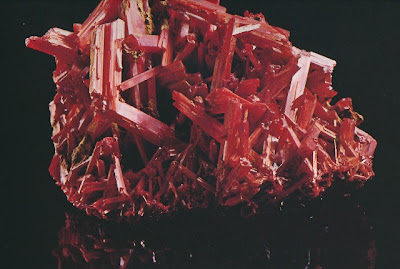
Some of the most interesting collections that I've seen are those which consist of the fruits of Mother Nature's labor. Natural things like shells, rocks, and bird nests (not really made by Mother Nature but rather Mama Bird.) Through the years, I have collected shells, pine cones (I once had a great cache of enormous pine cones from South Georgia, but they disappeared during a move a few years back), and even acorns. For some odd reason, I absolutely love acorns.
The most striking of all natural collections are minerals. Now I don't know much about minerals, something that I attribute to my utter lack of interest in chemistry and geology, but I do admire their beauty. And the more organic looking they are, the better. Out of curiosity, I recently bought a 1974 book titled Minerals: Nature's Fabulous Jewels, written by Ian Campbell and Arthur Court. (Yes, the very same Arthur Court of aluminum tableware fame.) Both Court and Campbell are noted mineral collectors, and many specimens from their collections were photographed for this book. The examples are really quite stunning thanks to their fantastic shapes, unusual colors, and heavy texture. After reading the book, I'm sorry that I didn't pay more attention in science class. Well, almost.

Part of Court's collection of minerals that have been mounted.
Mimetite and Plumbogummite from Alston Moor, Cumberland, England
Halite from Brawley, California
Crocoite, from Comet Mine, Dundas mining district, Tasmania, Australia
Chrysocolla "stalagmites" and drusy Quartz, from Concepcion del Oro, Mexico
Calcite with Limonite, from American Nettie Mine, Ouray mining district, Colorado
Bayldonite, from Tsumeb, South-West Africa.
Azurite and Malachite, from Apex Mine, St. George, Utah.
Autunite, from Daybreak Mine, Mount Spokane, Washington
All photos from Minerals: Nature's Fabulous Jewels by Arthur Court and Ian Campbell, M. Halberstadt photographer.
Home »Unlabelled » Nature's Fabulous Jewels
Nature's Fabulous Jewels
2:11 AM
apa ya






No comments:
Post a Comment